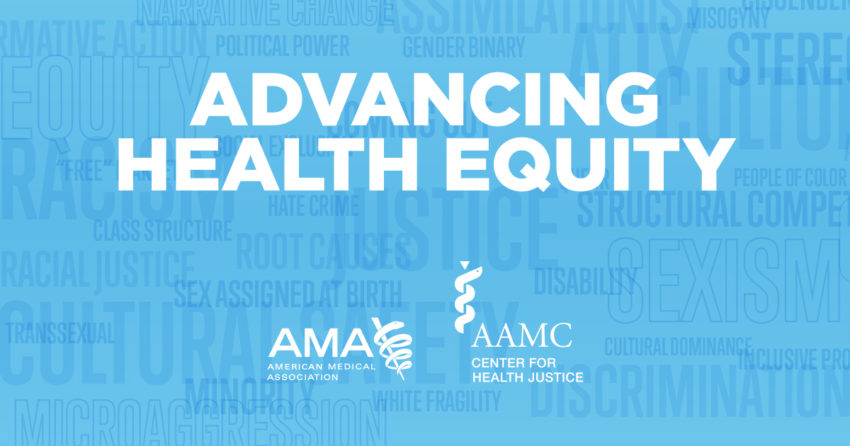
Share On Social!
The AAMC Center for Health Justice and American Medical Association (AMA) co-developed a new guide on inclusive language to advance health equity.
“Designed for physicians and other health care professionals, Advancing Health Equity: AMA-AAMC Guide on Language, Narrative, and Concepts provides guidance and promotes a deeper understanding of equity-focused, first-person language and why it matters,” according to the AAMC Center for Health Justice.
The guide is broken down sections on language to use to promote health equity, why these narratives matter, and a glossary that defines key terminology.
Using inclusive language is important for healthcare providers to ensure that they are giving culturally comprehensive care that is absent of implicit bias or discrimination, which unfortunately affects many Latinos and other people of color.
Learn about the new health equity language guide and how these narratives can affect Latinos in the doctor’s office.
What is in the Health Equity Guide?
The AAMC Center for Health Justice and AMA co-produced this guide to help shift the narrative about health equity and to show how language is interconnected with the fight for justice.
“As we explore in this guide, dominant narratives (also called malignant narratives), particularly those about ‘race,’ individualism and meritocracy, as well as narratives surrounding medicine itself, limit our understanding of the root causes of health inequities,” according to the guide.
Several recommendations in the guide reflect guidance from the CDC, as per their Health Equity Guiding Principles for Unbiased, Inclusive Communication:
- Avoid use of adjectives such as “vulnerable” and “high-risk.”
- Avoid dehumanizing language. Use person-first language instead.
- Remember that there are many types of subpopulations.
- Avoid saying “target,” “tackle,” “combat” or other terms with violent connotation when
referring to people, groups or communities. - Avoid unintentional blaming.
The guide indicates terms or phrases that are stigmatizing or out-of-date and suggests alternatives.
For example, one commonly used stigmatizing term is “illegal immigrant.”
A better term to use is “undocumented immigrant.”

“‘Illegal’ is a dehumanizing, derogatory term used to describe a person who resides in a country without proper documentation. No human being is illegal,” according to the guide.
Another portion of the guide focuses on using a systemic equity lens over an individualistic lens to examine power structures at play.
“Instead of stigmatizing individuals and communities for being vulnerable, we begin to recognize the conditions and power relations that create vulnerability. People are not vulnerable; they are made vulnerable,” according to the guide.
The guide suggests asking questions such as “What types of social change is necessary to confront health inequity?” and “What are the ways public health, with their allies, can organize for social change directed to meeting human need for health and well-being?”
All of this leads to building a health equity-based public narrative, which the guide describes as:
- Focusing attention on inequitable systems, hierarchies, social structure, power relations, and
institutional practices to reveal the sources of inequalities and the mechanisms that
sustain them. - Avoiding both blaming individuals for their condition or assuming that inequity can
be resolved through programmatic fixes that ignore the social responsibility of
corporations and government agencies. - Encouraging public dialogue on structural racism and all forms of oppression and inequity
to encourage a broad public response. - Fostering efforts to strengthen community-driven initiatives that fundamentally improve
well-being.
To access the guide, visit www.ama-assn.org/equity-guide.
Why Is Equitable Language Important for Latinos?
Changing the narrative and being intentional about the language we use is important so that we avoid acting on implicit biases.
Bias is the tendency to favor one group over another. It can be harbored in preconceived notions or stereotypes that affect our actions and understandings of others.
“Implicit bias has a real-world effect on behavior. It impacts employment, education, criminal justice, and more. Most healthcare providers, for example, have implicit bias ─ positive attitudes toward white patients, and negative attitudes toward patients of color,” according to a Salud America! research review.
There are many ways that implicit bias impacts Latinos and other patients of color:
For example:
- Latino men are less likely to receive treatment for high-risk prostate cancer than white men.
- Latinas and other pregnant women of color face discrimination from healthcare providers. This is due not only due to their race, but also their socioeconomic status.
- White male doctors are less likely to prescribe pain medications to Black patients than white patients.
- People of color who visit an emergency room in the U.S. are less likely to receive prescriptions for certain medications than white people.
How Can We Fight Implicit Bias & Advocate for Health Equity?
When we use problematic language that reinforces stereotypes or inequities, we may be using implicit bias.
This can lead to discrimination and health disparities.
Fortunately, implicit bias can be “rewired.”
Download the free Salud America! Action Pack “Health Care Workers and Researchers: Find If You Have Implicit Bias and What to Do Next.”
“This Action Pack will help you see if you have implicit bias, learn from others who have overcome their own implicit bias, and encourage colleagues to learn about implicit bias, too,” said Dr. Amelie G. Ramirez, director of the Salud America! at UT Health San Antonio, who created the Action Pack.
Explore More:
Overcoming Harmful BiasesBy The Numbers
3
Big Excuses
people use to justify discriminatory behavior



